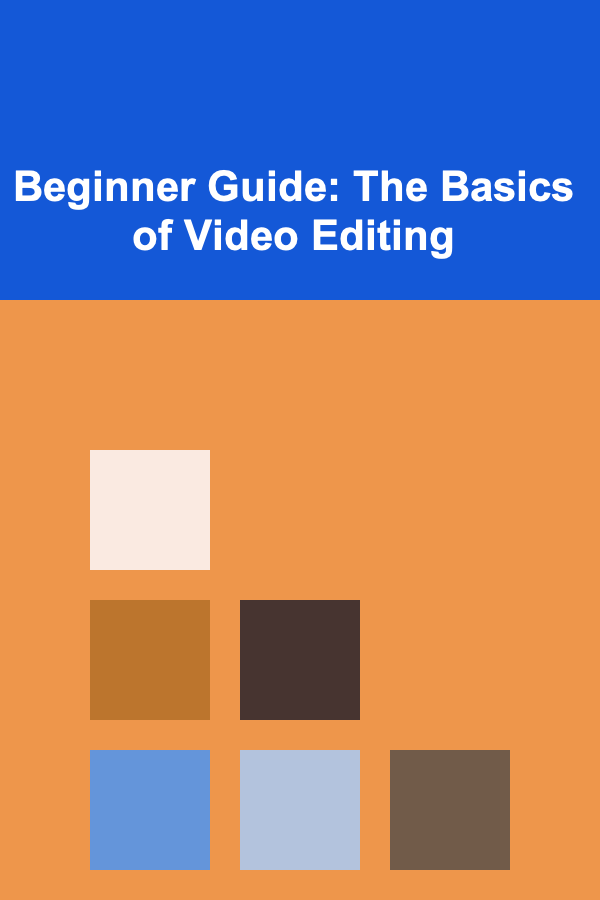
Beginner Guide: The Basics of Video Editing
ebook include PDF & Audio bundle (Micro Guide)
$12.99$10.99
Limited Time Offer! Order within the next:

Video editing is an essential skill in today's digital world, whether you're creating content for YouTube, social media, or personal projects. The process of turning raw footage into a polished final product can be daunting for beginners, but with the right knowledge, anyone can learn how to edit videos effectively. This guide will take you through the fundamentals of video editing, from understanding the tools you need to tips for creating professional-quality videos.
Understanding the Video Editing Process
Video editing is a step-by-step process that involves manipulating and rearranging video clips to tell a story or convey a message. At its core, it's about choosing the best footage, trimming unnecessary parts, and enhancing the visual and auditory experience of your content.
Key Stages in Video Editing:
- Importing Footage: First, you need to get your raw footage into the editing software. This typically involves transferring files from your camera or smartphone to your computer.
- Organizing Clips: Before you start editing, it's important to organize your clips so that you can easily find what you need. Most video editors allow you to create bins or folders to sort your clips.
- Rough Cut: This is where you assemble your clips in a sequence, removing unnecessary footage and creating a basic structure for your video.
- Fine Cut: Once the rough cut is done, you go back to make more precise edits, adjusting timing, transitions, and trimming footage to improve pacing.
- Adding Effects and Enhancements: This stage involves adding visual effects, color correction, sound effects, and music to enhance the video's overall quality.
- Exporting: Finally, you export your video in a format suitable for sharing, whether that's on YouTube, Vimeo, or social media.
Understanding these basic stages will help you manage the editing process and stay organized throughout.
Choosing the Right Video Editing Software
One of the first decisions you'll need to make as a beginner is choosing the right video editing software. There are many options available, ranging from free basic software to professional-grade tools.
Free Video Editing Software for Beginners:
- iMovie (Mac): iMovie is a simple video editor that comes pre-installed on Apple devices. It's perfect for beginners who need to perform basic editing like cutting, trimming, and adding transitions.
- Shotcut (Windows, Mac, Linux): Shotcut is an open-source video editing software that provides a range of features for beginner to intermediate users. It supports a variety of file formats and offers video filters, transitions, and audio editing tools.
- DaVinci Resolve (Windows, Mac, Linux): DaVinci Resolve offers professional-grade video editing and color grading tools for free. While it may have a steeper learning curve, it's a great option if you want to grow your editing skills over time.
Professional Video Editing Software:
- Adobe Premiere Pro (Windows, Mac): Premiere Pro is one of the most widely used video editing software for professionals. It offers advanced features like multi-camera editing, motion graphics, and support for 4K video. However, it requires a subscription.
- Final Cut Pro (Mac): Final Cut Pro is another industry-standard tool for Mac users, offering powerful editing features with a more intuitive interface compared to Adobe Premiere.
- Avid Media Composer (Windows, Mac): Avid is often used in the film and television industry and is known for its robust media management and collaboration features.
As a beginner, it's important to start with a user-friendly editor and gradually move on to more advanced tools as your skills grow.
Basic Video Editing Techniques Every Beginner Should Know
Once you've chosen your video editing software, it's time to learn some essential editing techniques. Below are some of the fundamental editing skills you'll need to master.
3.1. Trimming and Cutting Clips
Trimming and cutting are two of the most basic but essential skills in video editing. When editing your footage, you'll often want to remove unnecessary sections of the video or adjust the timing of scenes.
- Trimming: Trimming refers to cutting off the beginning or end of a clip. It's useful for removing dead space or getting to the action more quickly.
- Cutting: Cutting means removing a portion from the middle of the clip. This allows you to shorten scenes, cut out mistakes, or remove unwanted content.
3.2. Transitions
Transitions are effects that help move from one clip to another smoothly. Some common transitions include:
- Cut: A direct transition from one shot to another without any effect.
- Fade: A gradual transition from black (or any color) to the clip or from the clip to black.
- Dissolve: One clip slowly fades into another, often used to signify a passage of time or a change in scene.
Using transitions sparingly and effectively can make your video feel more polished and professional.
3.3. Adding Text and Titles
Text and titles help convey important information, such as the title of your video, the name of a speaker, or captions. Basic text editing allows you to create overlays, lower thirds (text at the bottom of the screen), and even animated titles.
3.4. Color Correction and Grading
Color correction is the process of adjusting the colors in your video to make them more accurate and balanced. For instance, you might want to correct the white balance or increase the contrast for a more vibrant image.
Color grading, on the other hand, is the artistic process of applying specific color tones to create a desired mood or style. Popular color grading techniques include making the footage warmer (yellow/orange) for a sunny, relaxed feel or cooler (blue/green) for a more somber, cold tone.
3.5. Audio Editing
Good audio is just as important as good video. Poor sound quality can ruin even the most beautifully edited footage. Make sure to:
- Adjust audio levels: Ensure the background music isn't louder than dialogue.
- Add sound effects: Enhance scenes with subtle sound effects, such as footsteps, ambient noise, or soundscapes.
- Remove background noise: Use noise reduction tools to clean up unwanted hums, hisses, or static.
Most video editing software includes basic audio editing tools, allowing you to adjust levels, fade in/out, and remove noise.
3.6. Adding Music and Soundtracks
Background music can greatly enhance the mood of your video. Choose music that complements the tone of your content---something upbeat for a tutorial or something calming for a nature video. Many free and paid music libraries are available, such as:
- YouTube Audio Library (Free)
- Artlist (Paid)
- Epidemic Sound (Paid)
Make sure the music you choose doesn't overpower dialogue or distract from the video's message.
Exporting Your Video
Once you're satisfied with your video, it's time to export it. Exporting refers to the process of rendering your video into a single file that can be shared or uploaded online. The export settings will depend on the platform you're using to share your video.
Common Export Settings:
- Resolution: Choose the resolution based on the platform's requirements. Common resolutions are 1080p (Full HD) and 4K.
- Frame Rate: Choose the appropriate frame rate (usually 24fps, 30fps, or 60fps) depending on the type of video.
- File Format: Most platforms accept MP4 files with H.264 encoding, which provides a good balance between file size and video quality.
- Bitrate: A higher bitrate usually results in better video quality but larger file sizes.
Be sure to preview the export settings and check the quality of the exported file before uploading.
Tips for Improving Your Video Editing Skills
- Practice Regularly: The more you practice, the better you'll become at editing. Experiment with different techniques and tools to discover what works best for your style.
- Watch Tutorials: There are countless free tutorials online that can help you master specific techniques. YouTube, in particular, is an excellent resource.
- Be Patient: Video editing can take time, especially when you're starting out. Don't rush the process---focus on improving your skills over time.
Conclusion
Video editing is a powerful and creative skill that anyone can learn with practice and patience. As a beginner, mastering the basics---such as cutting clips, adding transitions, and improving audio---will set you on the path to creating high-quality videos. With the right tools and knowledge, you'll be able to transform raw footage into compelling visual stories that captivate your audience. Keep experimenting, learning, and refining your skills to become a proficient video editor.
Reading More From Our Other Websites
- [Reading Habit Tip 101] Seasonal Reading Routines: Adjusting Your Book Habits for Spring, Summer, Fall, and Winter
- [Home Budget Decorating 101] How to Design Inexpensive Guest Room Ideas That Wow: Comfort Without the Cost
- [Polymer Clay Modeling Tip 101] From Soft to Solid: A Step-by-Step Guide to Baking Polymer Clay at the Right Heat
- [Home Pet Care 101] How to Design a Pet-Friendly Living Room for Relaxation
- [Simple Life Tip 101] How to Curate a Minimalist Wardrobe That Reflects Your Personal Style
- [Digital Decluttering Tip 101] Simple Steps to Declutter Your Smartphone and Boost Productivity
- [Organization Tip 101] How to Organize Shoes by Occasion: Casual, Formal, and More
- [Home Pet Care 101] How to Incorporate Pet Dental Care into Your Daily Routine
- [Home Holiday Decoration 101] How to Set Up a Holiday Photo Wall to Capture Seasonal Memories
- [Personal Care Tips 101] How to Choose the Best Personal Care Products for Fine Hair That Add Volume Without Weighing It Down

How to Budget for Moving Expenses and Save Money
Read More
How to Stage Your Home Without Overwhelming Potential Buyers
Read More
Navigating Clinical Trials: A Comprehensive Guide for Clinical Research Coordinators
Read More
How To Discuss Religion Openly and Respectfully
Read More
How to Navigate Ethical Dilemmas in Child Welfare
Read More
Bachelorette Party Checklist: How to Delegate Tasks Effectively
Read MoreOther Products

How to Budget for Moving Expenses and Save Money
Read More
How to Stage Your Home Without Overwhelming Potential Buyers
Read More
Navigating Clinical Trials: A Comprehensive Guide for Clinical Research Coordinators
Read More
How To Discuss Religion Openly and Respectfully
Read More
How to Navigate Ethical Dilemmas in Child Welfare
Read More